What type of art was created during the Byzantine art movement?
Hellenistic and Christian-themed paintings, sculptures, mosaics and mixed-media artwork was made during the Byzantine art movement. These artworks featured muted shades of brown, ochre and yellow. Sometimes, they even had gold embellishments that further gave artworks a yellow hue.
When did the Byzantine art movement become popular?
The Byzantine Empire roughly spanned between the year 330 AD to 1453 AD. During this time in the empire, the Byzantine art movement took place.
Where was Byzantine art made and popularised?
The Byzantine art movement took place in the Byzantine or Eastern Roman Empire. The Byzantine Empire roughly covered parts of areas like Greece, Italy, Türkiye, Egypt and other regions near the Mediterranean Sea. However, this art movement spread beyond these regions to modern-day Ukraine, Russia and other European regions.
What are the characteristics of Byzantine Art?
Gods in the Greek and Roman Empire along with Christian characters were preferred subjects of Byzantine artwork. Distinct narrow noses, piercing stares, ochre skin, sharp edges, prominent angles and clothing from around the 4th century make these scenes unmistakably Byzantine. This movement is divided into three segments because of the political and social influences of the time.
- Early Byzantine – The beginning of this phase in the Roman Empire under Constantine and the adoption of Christianity.
- Middle Byzantine – Macedonian Renaissance where artists were taking an interest in Greek history.
- Late Byzantine – Beginning with the fourth Crusade in 1204
It is nothing new that paintings are based on religious and mythological figures. However, the Byzantine art movement was different because artwork did not aim to look realistic but rather quite abstract. Byzantine artwork barely had shadows and highlights in a way that an object would normally have in nature. Very few curvy and naturalistic lines were used, it was mostly straight lines, pointy angles, thick lines and contrasting backgrounds. These paintings almost looked like collage cutouts glued on a parchment without background scenery.
Top 10 Famous Artworks and Artists of the Byzantine Art Movement
Christ Pantocrator Mosaic at Hagia Sophia

The word Pantocrator means “ruler over all.” This was a common term associated with Christ, as a result, it is not unusual for many artworks bearing the image of Christ to have the word “Pantocrator” in the title. The Pantocrator at the Hagia Sophia church is one of the most famous among Byzantine Christ Pantocrator artworks. This particular one is a mosaic with coloured stones and gold details. The two chief colours of sapphire blue and yellow gold make an attractive complementary palette of just a few colours.
The Mosaic of Emperor Justinian and his Retinue
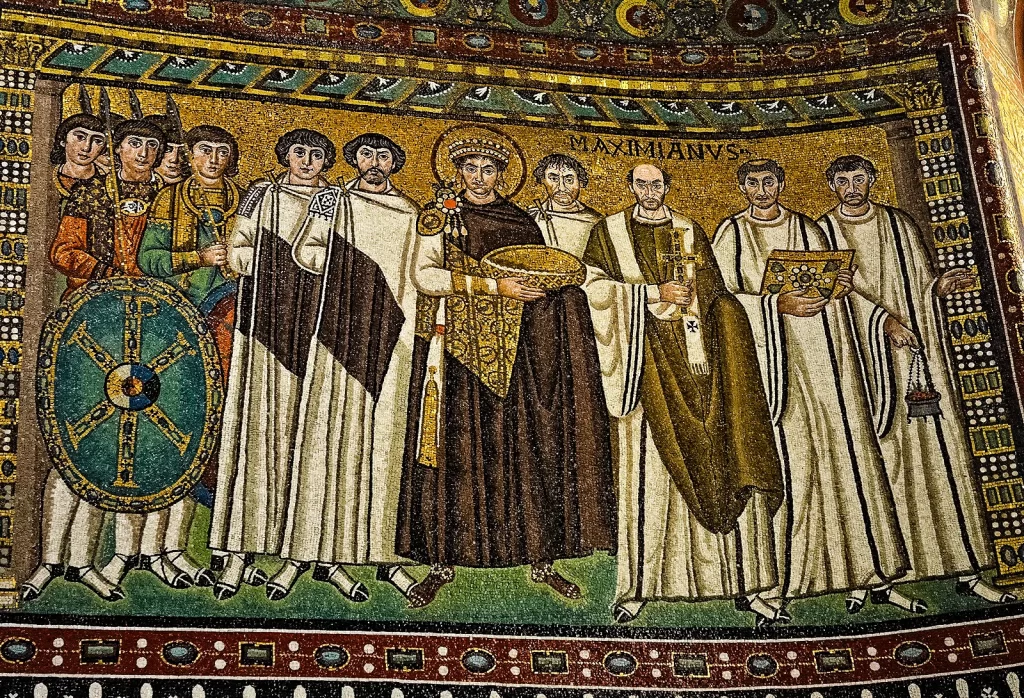
This mosaic features Emperor Justinian and his courtiers at the church of San Vitale at Ravenna in Italy. This artwork is almost like a “group photo” of the emperor and his colleagues in the modern sense. Needless to say, an artwork of such an officious subject has muted colours. However, this can be said about most Byzantine artwork. The outlines are prominent, colours are flat with barely any shadows or highlights. The robes of the people in the painting also give the artwork these long vertical lines that made them look taller in a way. Perhaps the artist was asked to make the subjects look intimidating because of their high social stature.
Our Lady of the Don by Theophanes the Greek
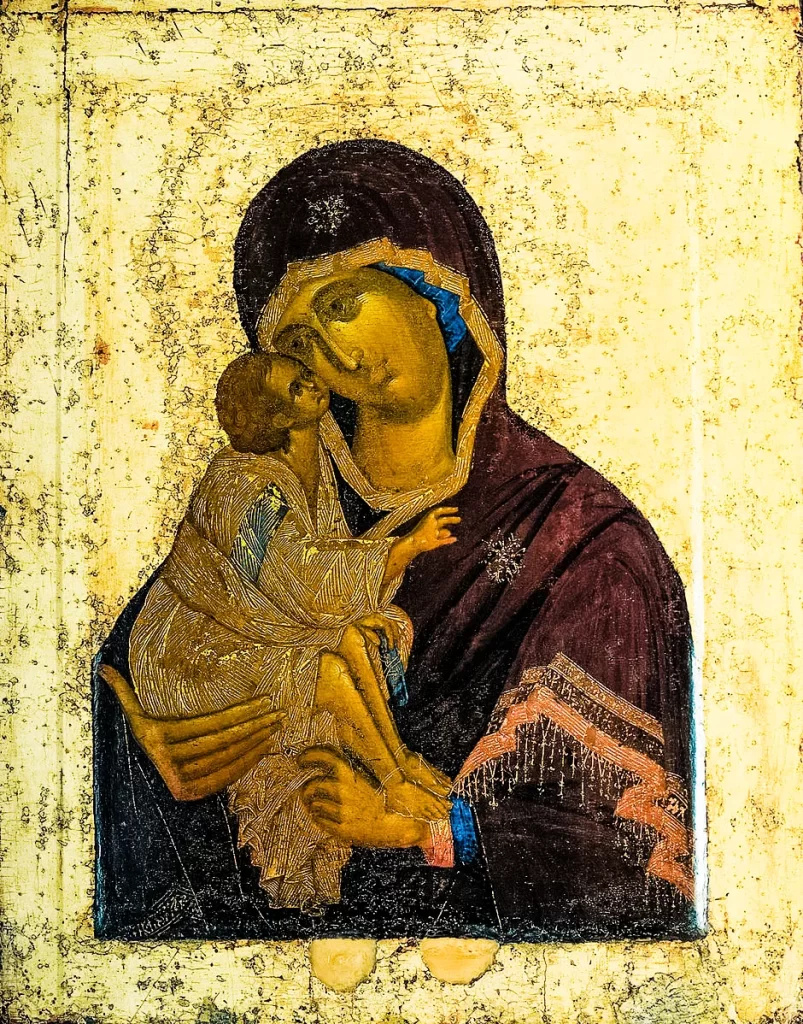
If you are looking for an iconic painting from the middle-ages, look no further. If Andy Warhol is the father of pop art then Theophanes the Greek was the master of iconography. This particular image of Mary and Jesus is easily one of the most recognised across the globe. Theophanes’ painting style even went on to influence the Novgorod school. The use of rigid, easily defined lines, plain backgrounds and solid colours makes this simple image easy to remember and convenient to produce in print. Perhaps this is why it is still used today in ecclesiastic and artistic editorials.
Ohrid Annunciation Icon
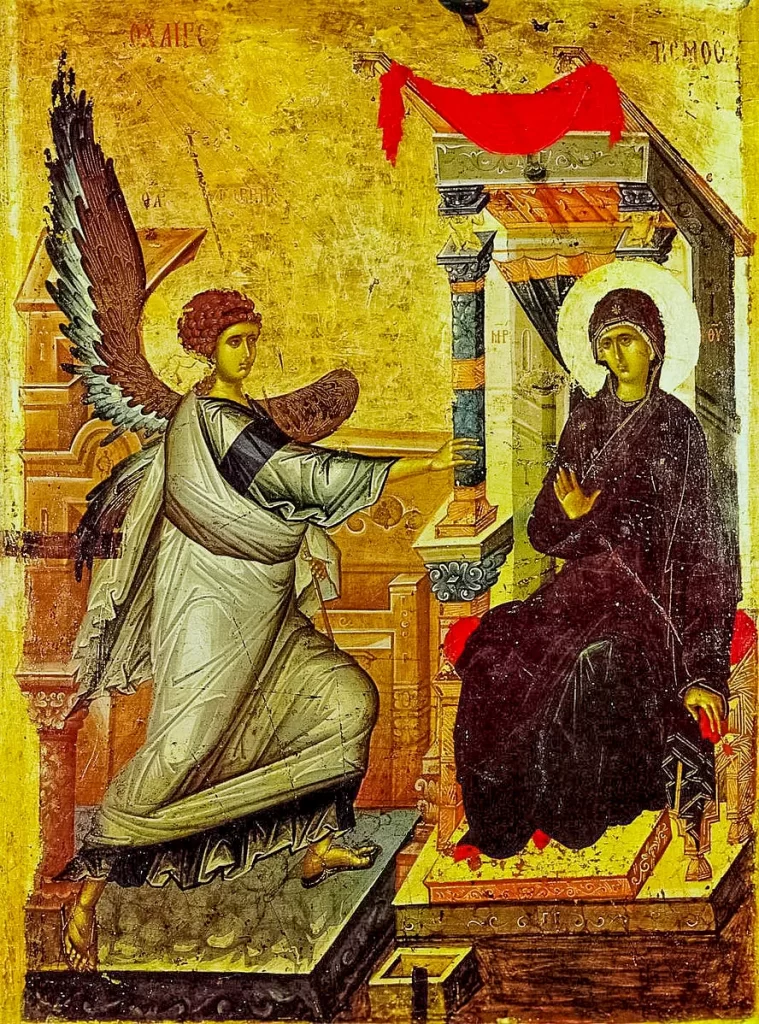
Just like most Byzantine pieces, this artwork too has a gold background. The figures in this artwork are Angel Gabriel in white and Mary in a dark robe. The facial features with thin noses, fish-shaped eyes with droopy eyelids, ochre skin tones and defined, rigid lines are quintessentially Byzantine. However, the standout feature of this artwork is actually quite unexpected. Mary sits on a gold throne with ornamental details. The red drape at the top of the throne is one of the most eye-catching feature of this painting. The position of the drape is made to look like it looms over Mary’s head as she is about to be told that she will bear the child of God. Perhaps this is what the artist wanted to allude to.
Christ Acheiropoieta
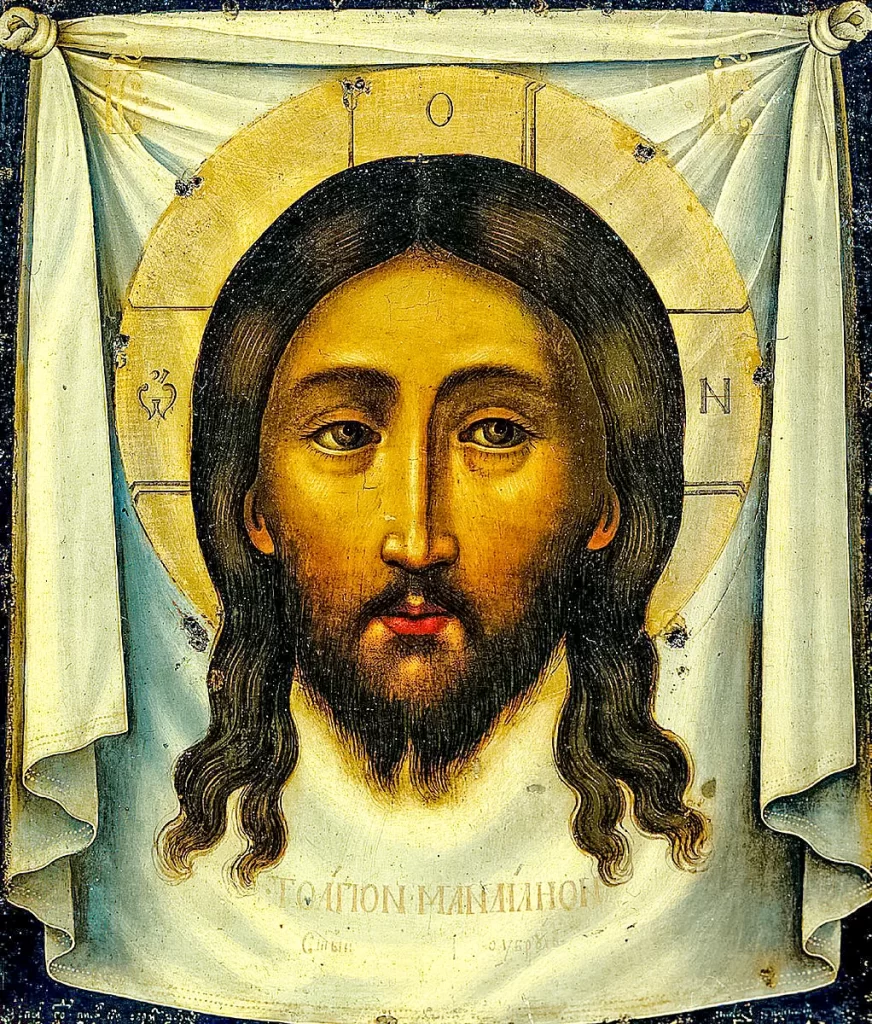
The word Acheiropoieta means “made without hands” in medieval Greek. This painting and other variants with this word in the title stems from the indication that these icons were “miraculous” images that did not involve human hands in its creation. This particular image by Simon Ushakov is of Christ’s face imprinted on a cloth. This is from the biblical extract where Veronica acquires a print of Jesus’ face on a piece of cloth when she tries to wipe his injured face. In other words, if this is a painting of a printed image, Acheiropoieta is sort of like an “Inception” of artworks.
Christ the Saviour Pantocrator of Sinai
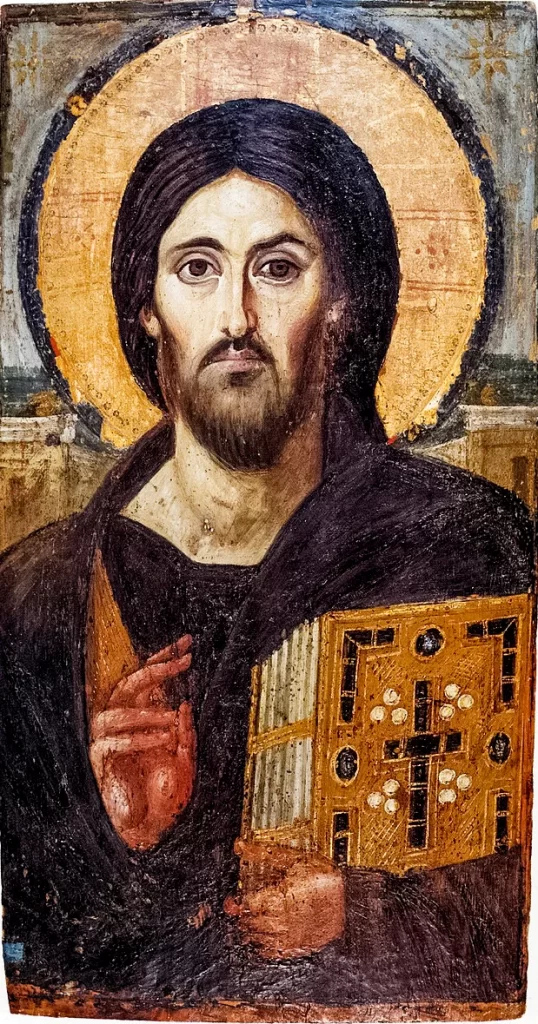
At St. Catherine’s Monastery in Sinai rests one of the oldest Byzantine works, another Christ Pantocrator. There are a few oddities in this particular image that might be accidents or intentional, we might never know. In most Byzantine art, both eyes in human figures tend to be uniform and it looks as if they are staring at the viewer. That is not the case with the Pantocrator of Sinai. The iris of the right eye looks larger than the one on the left. Because of this, if you were to cover one half of the face, one at a time, you would notice that the expression on each side of the face seems to depict a different emotion. The left side looks sad with a hint of pity and the right side looks almost regal. This painting also has a scenery background and the use of shadows in the face, which is really rare for Byzantine art.
St Luke, Hosios Loukas, Distomo
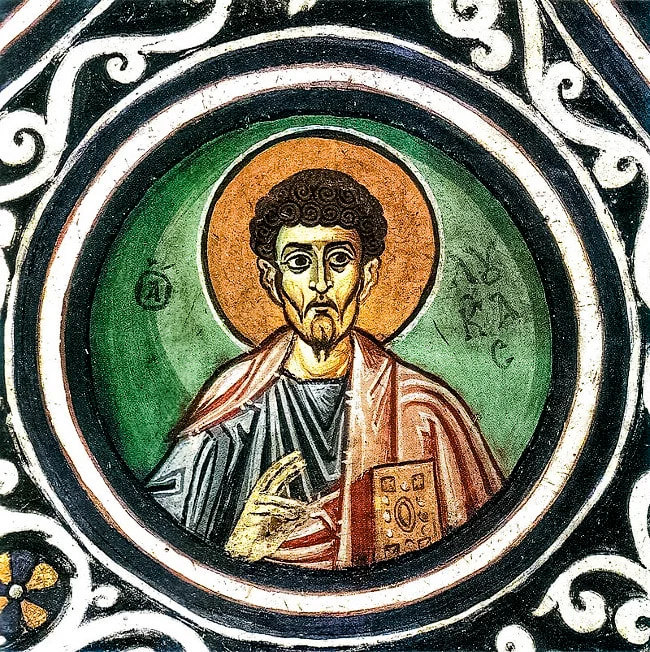
Hosios Loukas is a monastery located in Greece. The walls of this monastery are decked with paintings and mosaics from the Byzantine art movement. One of the images is of St. Luke with a blue and red tunic. This icon has four dominant colours, red, blue, green and dark yellows. The artist has used lines as a medium to outline the subject, give him emotions, give him ethnic features like curls, give his tunic folds and even used lines to give his tunic shadows and highlights. Line art lovers must feast their eyes on this artwork.
Iconostasis Archangel Michael by Ivan Rutkovych from Skvariava Nova
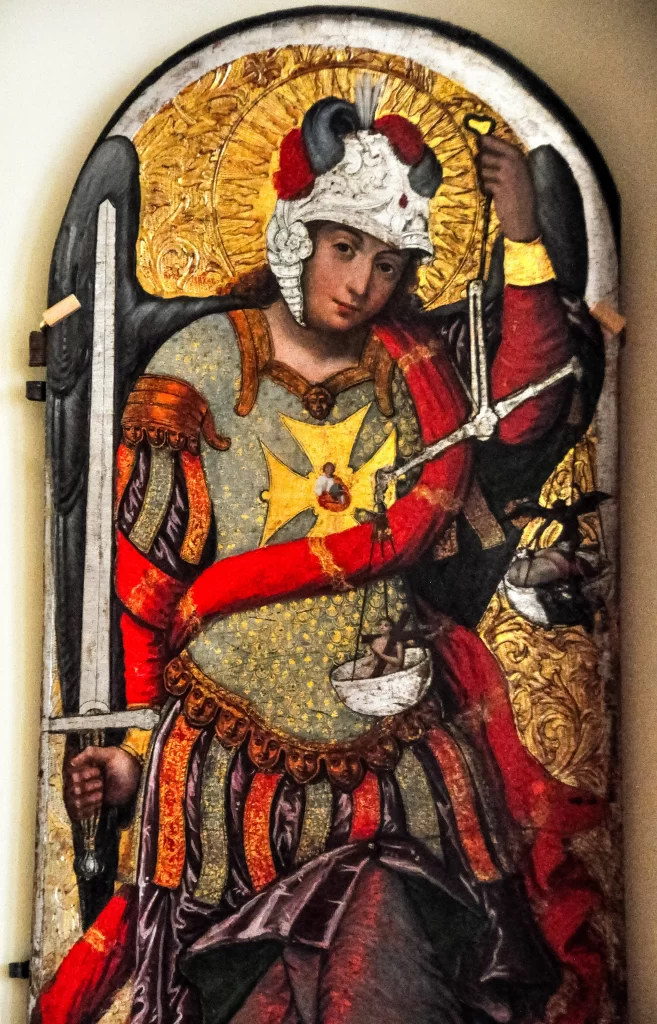
Ivan Rutkovych the founder of Zhovkva Iconographic School of Painting and Wood Carving made the Iconostasis in a very Ukrainian-Byzantine style. Since this was in the late Byzantine period, it had more colour and embellishment. Red, gold, silver and even more detailing in the face and clothing. You can almost spot similarities with European art movements. The facial features are not as flat and “2D” as the older Byzantine artworks. This is why this artwork seems to have more depth than its predecessors within the movement.
The Altarpiece by Nikolaos Philanthropinos
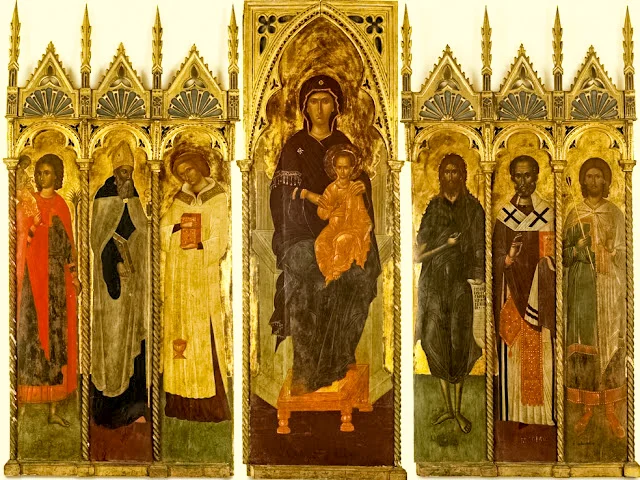
Nikolaos Philanthropinos was given the commission of this diptych altarpiece during the end of the Byzantine period and the beginning of the Palaeologan Renaissance period. This means that this altarpiece had trademark Byzantine figures with narrow noses, uniform eyes and faces that pointed to the viewer. However, it also had Palaeologan Renaissance qualities like the use of soft shadows, finer lines and a wider range of colours.
The Empress Theodora Wife of Justinian I San Vitale Ravenna

The subject of this detailed mosaic was a powerful and prominent figure in the early Byzantine Empire. Theodora was the wife of Justinian I and an advocate of religious and social rights within her empire. The mosaic details, her headgear and jewels surely indicate her stature. The colour details like the pink in her cheeks and shadows in her eyes and robes are carefully crafted with varying shades of mosaic pieces.
The Byzantine period was expansive, both, in terms of geography and time itself. More than a thousand years across North Africa, Europe and Eurasia makes the Byzantine Art Movement one of the most successful movements of all time with artworks that are recognisable and loved even today.
Images: Wiki Commons







0 Comments